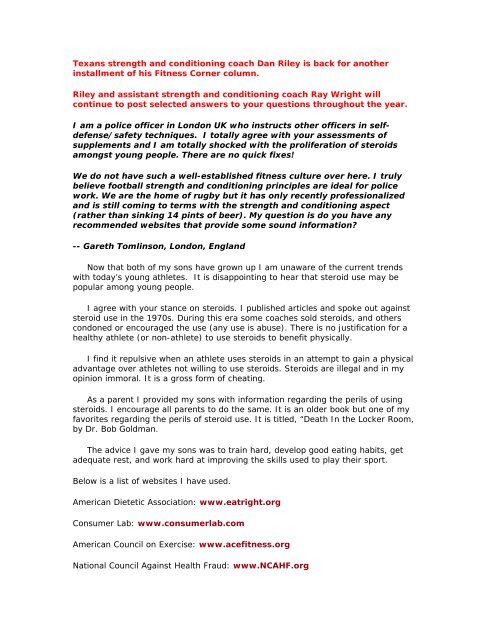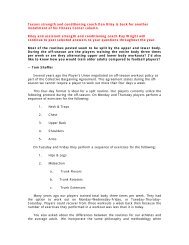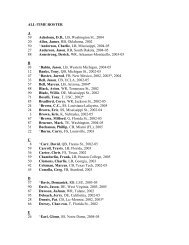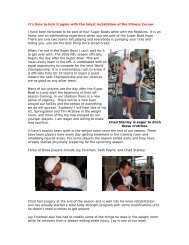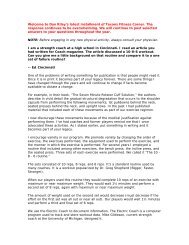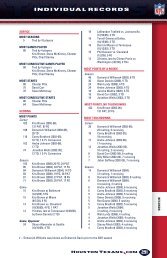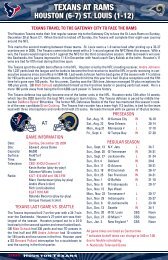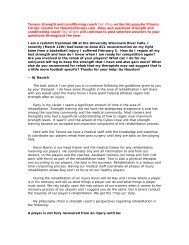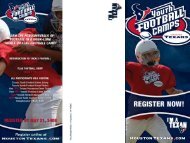Texans strength and conditioning coach Dan Riley is back for ...
Texans strength and conditioning coach Dan Riley is back for ...
Texans strength and conditioning coach Dan Riley is back for ...
Create successful ePaper yourself
Turn your PDF publications into a flip-book with our unique Google optimized e-Paper software.
<strong>Texans</strong> <strong>strength</strong> <strong>and</strong> <strong>conditioning</strong> <strong>coach</strong> <strong>Dan</strong> <strong>Riley</strong> <strong>is</strong> <strong>back</strong> <strong>for</strong> another<br />
installment of h<strong>is</strong> Fitness Corner column.<br />
<strong>Riley</strong> <strong>and</strong> ass<strong>is</strong>tant <strong>strength</strong> <strong>and</strong> <strong>conditioning</strong> <strong>coach</strong> Ray Wright will<br />
continue to post selected answers to your questions throughout the year.<br />
I am a police officer in London UK who instructs other officers in selfdefense/safety<br />
techniques. I totally agree with your assessments of<br />
supplements <strong>and</strong> I am totally shocked with the proliferation of steroids<br />
amongst young people. There are no quick fixes!<br />
We do not have such a well-establ<strong>is</strong>hed fitness culture over here. I truly<br />
believe football <strong>strength</strong> <strong>and</strong> <strong>conditioning</strong> principles are ideal <strong>for</strong> police<br />
work. We are the home of rugby but it has only recently professionalized<br />
<strong>and</strong> <strong>is</strong> still coming to terms with the <strong>strength</strong> <strong>and</strong> <strong>conditioning</strong> aspect<br />
(rather than sinking 14 pints of beer). My question <strong>is</strong> do you have any<br />
recommended websites that provide some sound in<strong>for</strong>mation<br />
-- Gareth Tomlinson, London, Engl<strong>and</strong><br />
Now that both of my sons have grown up I am unaware of the current trends<br />
with today’s young athletes. It <strong>is</strong> d<strong>is</strong>appointing to hear that steroid use may be<br />
popular among young people.<br />
I agree with your stance on steroids. I publ<strong>is</strong>hed articles <strong>and</strong> spoke out against<br />
steroid use in the 1970s. During th<strong>is</strong> era some <strong>coach</strong>es sold steroids, <strong>and</strong> others<br />
condoned or encouraged the use (any use <strong>is</strong> abuse). There <strong>is</strong> no justification <strong>for</strong> a<br />
healthy athlete (or non-athlete) to use steroids to benefit physically.<br />
I find it repulsive when an athlete uses steroids in an attempt to gain a physical<br />
advantage over athletes not willing to use steroids. Steroids are illegal <strong>and</strong> in my<br />
opinion immoral. It <strong>is</strong> a gross <strong>for</strong>m of cheating.<br />
As a parent I provided my sons with in<strong>for</strong>mation regarding the perils of using<br />
steroids. I encourage all parents to do the same. It <strong>is</strong> an older book but one of my<br />
favorites regarding the perils of steroid use. It <strong>is</strong> titled, “Death In the Locker Room,<br />
by Dr. Bob Goldman.<br />
The advice I gave my sons was to train hard, develop good eating habits, get<br />
adequate rest, <strong>and</strong> work hard at improving the skills used to play their sport.<br />
Below <strong>is</strong> a l<strong>is</strong>t of websites I have used.<br />
American Dietetic Association: www.eatright.org<br />
Consumer Lab: www.consumerlab.com<br />
American Council on Exerc<strong>is</strong>e: www.acefitness.org<br />
National Council Against Health Fraud: www.NCAHF.org
Gatorade Sports Science Institute: www.gssiweb.com<br />
Tufts University Health & Nutrition Letter: www.healthletter.tufts.edu<br />
American College of Sports Medicine: www.acsm.org<br />
Human Kinetics Publ<strong>is</strong>hing Company: www.humankinetics.com<br />
Coach & Athletic Director: www.<strong>coach</strong>adguide.com<br />
Best of luck with your police work <strong>and</strong> your workouts.<br />
I am a high school <strong>strength</strong> <strong>and</strong> <strong>conditioning</strong> coordinator. I often need to<br />
suggest to <strong>coach</strong>es proper times to per<strong>for</strong>m <strong>strength</strong> training during the inseason.<br />
With time constraints such as school hours <strong>and</strong> practice sessions,<br />
sometimes-optimal conditions are hard to find. For maximum gains to be<br />
made during the season, when should the <strong>strength</strong> training sessions be<br />
scheduled Be<strong>for</strong>e or after practice, <strong>and</strong> why<br />
-- Ed Cicale, Oak Hills High School, Cincinnati, OH<br />
During the season time <strong>is</strong> tight <strong>for</strong> all <strong>coach</strong>es, to include <strong>strength</strong> <strong>coach</strong>es. I<br />
always joke with our head <strong>coach</strong> Dom Capers that games, practice, <strong>and</strong> meetings,<br />
get in the way of weight workouts.<br />
Each <strong>strength</strong> <strong>coach</strong> must decide how to most efficiently utilize h<strong>is</strong>/her facility<br />
with the time available. You are better prepared in your situation to decide what <strong>is</strong><br />
best <strong>for</strong> your players. You may be <strong>for</strong>ced to train players in conditions that are less<br />
than ideal.<br />
During the season my personal preference <strong>is</strong> to train our players be<strong>for</strong>e practice.<br />
After practice players can be fatigued. Th<strong>is</strong> may <strong>for</strong>ce a player to place a lower<br />
priority on exerting a maximum ef<strong>for</strong>t.<br />
I have mentioned many times how important in-season <strong>strength</strong> training must<br />
be. Strength <strong>is</strong> lost rapidly if a near maximum ef<strong>for</strong>t <strong>is</strong> not exerted each time a<br />
player works out. During the season our players use the exact same workouts that<br />
they used during the off-season.<br />
Our games are on Sunday. Our entire team per<strong>for</strong>ms a total body workout on<br />
Monday. Training the day after the game helps reduce <strong>and</strong> eliminate stiffness <strong>and</strong><br />
soreness. It also allows enough recovery time to per<strong>for</strong>m a second workout later in<br />
the week. All weight workouts on Monday are completed be<strong>for</strong>e our team looks at<br />
the game film in the afternoon.<br />
During the week on Wednesday, Thursday, <strong>and</strong> Friday, most of our players lift in<br />
the morning be<strong>for</strong>e meetings. We have some veterans who prefer lifting after<br />
practice.
I am fourteen years old <strong>and</strong> do not have any access to weights. So I do<br />
push-ups <strong>and</strong> an ab workout be<strong>for</strong>e I go to bed. How should I per<strong>for</strong>m my<br />
pushups to make the best <strong>strength</strong> gains<br />
(Name not included)<br />
When using bodyweight to per<strong>for</strong>m an exerc<strong>is</strong>e (push-ups, sit-ups, crunches, pullups,<br />
chin-ups, dips) people often become more concerned with "how many" reps<br />
they per<strong>for</strong>m rather than "how" they per<strong>for</strong>m each rep.<br />
For example when per<strong>for</strong>ming sit-ups (or crunches) athletes often jerk their body<br />
upward (incorporating momentum) <strong>and</strong> allow the upper body to ef<strong>for</strong>tlessly fall <strong>back</strong><br />
to the starting position, allowing the muscles to per<strong>for</strong>m little or no work during the<br />
lowering phase. We call these throw-ups <strong>and</strong> fall downs.<br />
The same can be observed when per<strong>for</strong>ming push-ups. The lifter drops to the<br />
floor rapidly, per<strong>for</strong>ming little or no work during the lowering phase <strong>and</strong> then<br />
bounces h<strong>is</strong> chest off the floor using some momentum to help recover to the starting<br />
position. Some athletes do not even recover to the starting position. They are<br />
basically per<strong>for</strong>ming half-rep pushups.<br />
Per<strong>for</strong>m any exerc<strong>is</strong>e with your bodyweight in the same manner as you would<br />
any other exerc<strong>is</strong>e. We ask our players to observe four rules while per<strong>for</strong>ming a<br />
repetition of any exerc<strong>is</strong>e (to include push-ups).<br />
1. Eliminate momentum during the ra<strong>is</strong>ing phase. Force the muscles to do all of<br />
the work.<br />
2. Pause momentarily in the muscles contracted position. More muscle fibers are<br />
recruited at th<strong>is</strong> point than in any other position.<br />
3. Emphasize the lowering of the weight (take longer to lower the weight). The<br />
same muscles are used to lower the weight. Significant <strong>strength</strong> gains can be<br />
developed from lowering a weight if more weight <strong>is</strong> used or more time <strong>is</strong> taken.<br />
4. Ra<strong>is</strong>e <strong>and</strong> lower the weight through the muscles full range of motion. If you are<br />
not getting an adequate stretch, elevate your h<strong>and</strong>s off the floor (place a some<br />
pads under each h<strong>and</strong>) to prevent your chest from touching the floor.<br />
Using a persons bodyweight <strong>for</strong> res<strong>is</strong>tance can create problems <strong>for</strong> some people.<br />
A person may not be strong enough to h<strong>and</strong>le h<strong>is</strong>/her own bodyweight. Th<strong>is</strong> <strong>for</strong>ces<br />
the person to abstain from per<strong>for</strong>ming certain exerc<strong>is</strong>es, or it <strong>for</strong>ces them to use<br />
terrible <strong>for</strong>m in an attempt to complete a set. If you cannot properly h<strong>and</strong>le your<br />
own bodyweight while per<strong>for</strong>ming push-ups we suggest the following:<br />
1. Per<strong>for</strong>m modified push-ups by dropping to your knees (only the h<strong>and</strong>s <strong>and</strong> knees<br />
touch the floor).<br />
2. Per<strong>for</strong>m negative only push-ups (only lower the weight). Allow 8 seconds to<br />
lower the weight <strong>and</strong> get <strong>back</strong> to the arms extended starting position position any<br />
way that you can. Per<strong>for</strong>m eight to ten reps at eight seconds per rep. Use a
stopwatch on the floor to monitor your lowering speed. Do not start counting until<br />
you have unlocked your arms. The lowering speed should be smooth <strong>and</strong> even. If<br />
you need more res<strong>is</strong>tance have a spotter apply some manual res<strong>is</strong>tance to your<br />
upper <strong>back</strong>.<br />
3. If you reach the point where you cannot per<strong>for</strong>m another push-up (while<br />
per<strong>for</strong>ming conventional push-ups) <strong>and</strong> want to per<strong>for</strong>m additional reps have a<br />
spotter ass<strong>is</strong>t by helping you recover to the starting position.<br />
The next time you per<strong>for</strong>m your push-up workout, get out the bathroom scale<br />
<strong>and</strong> place both h<strong>and</strong>s on the scale in the push-up position. Observe the weight<br />
reg<strong>is</strong>tered on the scale when you are in the push-up position. It <strong>is</strong> significantly less<br />
than your overall bodyweight (when you st<strong>and</strong> on the scale). Your bodyweight may<br />
not be enough to generate <strong>strength</strong> gains. It would be similar to bench-pressing 75<br />
pounds <strong>for</strong> fifty reps. Eventually you get tired, it burns, it hurts, yet you did nothing<br />
to build additional <strong>strength</strong>. At some point with a lighter weight, you stop increasing<br />
your anaerobic <strong>strength</strong> <strong>and</strong> begin improving your aerobic endurance.<br />
Your muscles will quickly adapt to whatever percentage of your bodyweight you<br />
are using to per<strong>for</strong>m push-ups. At th<strong>is</strong> point you must find a way to make the pushup<br />
harder if you want to continue to gain anaerobic <strong>strength</strong>. You cannot expect to<br />
provide the same overload one workout after another, <strong>and</strong> expect to get stronger.<br />
The same can be observed while per<strong>for</strong>ming sit-ups. The weight of your torso<br />
does not change from workout to workout. If you want your abdominal muscles to<br />
get stronger they will eventually need more res<strong>is</strong>tance. An exerc<strong>is</strong>e can burn <strong>and</strong><br />
hurt but it does not guarantee <strong>strength</strong> gains.<br />
You can make a bodyweight push-up more difficult by utilizing one or more of<br />
the following techniques:<br />
1. Take more time to ra<strong>is</strong>e the weight. We call them slow reps. Allow eight seconds<br />
to ra<strong>is</strong>e the weight.<br />
2. Have a spotter apply manual res<strong>is</strong>tance to your upper <strong>back</strong>. A spotter can push<br />
on your upper <strong>back</strong> while you ra<strong>is</strong>e <strong>and</strong> lower your weight. With a proper spot you<br />
should reach the point where you cannot complete another push-up somewhere<br />
between 10 <strong>and</strong> 12 reps.<br />
3. Elevate your feet. Use the stairs in your house to elevate your feet in the pushup<br />
position. The higher you elevate the feet the more difficult the exerc<strong>is</strong>e. Use your<br />
bathroom scale to see how much more of your bodyweight you are lifting when<br />
you begin to elevate your feet.<br />
5. Preexhaust your triceps be<strong>for</strong>e per<strong>for</strong>ming push-ups.<br />
a. For variety we periodically have our players per<strong>for</strong>m an exerc<strong>is</strong>e to <strong>is</strong>olate the<br />
triceps (triceps pushdowns) followed immediately with a set of ten push-ups (with a<br />
spotter adding manual res<strong>is</strong>tance). We manually add res<strong>is</strong>tance to their upper <strong>back</strong>.<br />
We add enough res<strong>is</strong>tance to allow them to barely complete 10 reps.
Why do football workouts train body parts more than once a week where as<br />
regular bodybuilding only train body parts once a week Aren’t football<br />
players over-training<br />
-- Jason Regala<br />
I am not real familiar with the routines employed by modern day bodybuilders so<br />
it makes it difficult <strong>for</strong> me to accurately compare workouts. My guess <strong>is</strong> that most<br />
bodybuilders per<strong>for</strong>m many more exerc<strong>is</strong>es <strong>and</strong> sets per body part than our players<br />
do. If the volume of exerc<strong>is</strong>e per<strong>for</strong>med <strong>is</strong> significant, more time <strong>is</strong> needed between<br />
workouts to recover.<br />
Keep in mind our longest upper body routine incorporates a total of twelve sets.<br />
The volume of exerc<strong>is</strong>e our players per<strong>for</strong>m <strong>is</strong> very low. Once they adapt to our style<br />
of training they can easily recover from two upper body <strong>and</strong> two lower body<br />
workouts in a week.<br />
I have publ<strong>is</strong>hed our routines in past Fitness Corner installations. Below <strong>is</strong> a<br />
sample of one of our 10 – 8 Routines:<br />
Set # Exerc<strong>is</strong>e Reps<br />
1 Dumbbell Bench Press 10 reps (Rest 90 seconds)<br />
2 Dumbbell Bench Press 8 reps (Rest 90 seconds)<br />
3 Nitro Pullover 10 reps<br />
4. Lat Pulldown 10 reps (Rest 90 seconds)<br />
5 Dumbbell Incline Press 10 reps (Rest 90 seconds)<br />
6 Dumbbell Incline Press 8 reps (Rest 90 seconds)<br />
7 Hammer Rear Delt 12 reps<br />
8 Hammer Seated Row 10 reps (Rest 90 seconds)<br />
9 Rotator Cuff External Rotation 12 reps (Rest 90 seconds)<br />
10 Lateral Ra<strong>is</strong>e 12 reps (Rest 90<br />
seconds)<br />
11 Dumbbell Seated Press 10 reps (Rest 90 seconds)<br />
12 Dumbbell Seated Press 8 reps<br />
Total # of reps per<strong>for</strong>med = 120 reps
You can observe from the upper body workout l<strong>is</strong>ted above, our players only per<strong>for</strong>m<br />
four exerc<strong>is</strong>es (36 total reps) <strong>for</strong> the chest, four exerc<strong>is</strong>es (42 total reps) <strong>for</strong> the<br />
upper <strong>back</strong>, <strong>and</strong> four exerc<strong>is</strong>es (42 total reps) <strong>for</strong> the shoulders.<br />
We do not waste time <strong>and</strong> energy by per<strong>for</strong>ming non-productive sets. Our players<br />
warm up on the first upper (or lower) body exerc<strong>is</strong>e by per<strong>for</strong>ming several<br />
preparatory sets. Once the warm-up process <strong>is</strong> complete our players exert a<br />
maximum or near-maximum ef<strong>for</strong>t on each set per<strong>for</strong>med.<br />
Some workouts require athletes to per<strong>for</strong>m an endless number of non-productive<br />
sets (sub-maximal ef<strong>for</strong>ts). The body must use some recovery energy on every<br />
repetition per<strong>for</strong>med regardless of how light the weight <strong>is</strong>. Hans Selye tells us that<br />
we do not have an unlimited supply of adaptation energy. The ability to recover from<br />
exerc<strong>is</strong>e <strong>is</strong> limited. There<strong>for</strong>e after warming up our players, every set must have a<br />
purpose. And that purpose <strong>is</strong> an attempt to increase <strong>strength</strong> on every set<br />
per<strong>for</strong>med each workout, until <strong>strength</strong> maintenance becomes the goal.<br />
In my early years with the Redskins our players per<strong>for</strong>med three total body<br />
workouts per week. The volume of exerc<strong>is</strong>e was less than our current twice per week<br />
workouts, but in looking <strong>back</strong> I firmly believe I was over-training our players.<br />
I have learned to l<strong>is</strong>ten to our harder working players <strong>and</strong> have made volume<br />
adjustments in our running program <strong>and</strong> our lifting program based upon their<br />
feed<strong>back</strong>.<br />
Dr. Hans Selye (in h<strong>is</strong> book, “The Stress of Life”) teaches us that one half of the<br />
successful fitness <strong>for</strong>mula <strong>is</strong> stress (exerc<strong>is</strong>e) <strong>and</strong> the other, <strong>and</strong> equally important<br />
half, <strong>is</strong> adaptation (rest).<br />
Too much exerc<strong>is</strong>e <strong>and</strong> not enough rest produce an athlete incapable of<br />
recovering from one workout (or practice) to the next. During my younger days I<br />
was guilty of over-training players. It can only be described as bad <strong>coach</strong>ing.<br />
I am constantly searching <strong>for</strong> in<strong>for</strong>mation that can help us better determine how<br />
little exerc<strong>is</strong>e <strong>is</strong> needed to produce the best results.<br />
Jason, your question about over-training <strong>is</strong> a good one. Some day I hope there<br />
will be a simple, scientific, <strong>and</strong> non-invasive method to monitor over-training. Until<br />
then we must rely upon keeping accurate records to compare progress from one<br />
workout to the next. We must also seek the opinions of our most d<strong>is</strong>ciplined workers<br />
<strong>and</strong> make adjustments when necessary.


